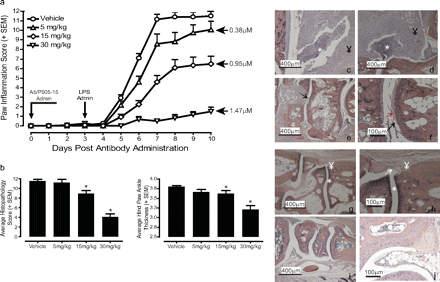This product is for research use only, not for human use. We do not sell to patients.

| Size | Price | Stock |
|---|---|---|
| 250mg | $1300 | In Stock |
| 500mg | $1950 | In Stock |
| 1g | $2925 | In Stock |
Cat #: V0652 CAS #: 1370261-97-4 Purity ≥ 98%
Description: PRT062607 (also known as P505-15, BIIB-057) HCl is a novel, potent, highly selective and orally bioavailable small molecule Syk inhibitor with potential anti-inflammatory activity. It inhibits Syk with an IC50 of 1 nM in cell-free assays, and shows >80-fold selectivity for Syk over other kinases such as Fgr, Lyn, FAK, Pyk2 and Zap70. PRT062607 produced excellent in vivo anti-inflammatory activity in two rodent models of rheumatoid arthritis. P505-15 successfully inhibited SYK-mediated B-cell receptor signaling and decreased cell viability in NHL and CLL. PRT062607effectively antagonize CLL cell survival after BCR triggering. Moreover, they inhibit the secretion of the chemokines CCL3 and CCL4 by CLL cells, and leukemia cell transfer toward beneath stromal cells, the tissue homing chemokines CXCL13 and CXCL12.
Publications Citing InvivoChem Products
Product Promise

- Physicochemical and Storage Information
- Protocol
- Related Biological Data
- Stock Solution Preparation
- Quality Control Documentation
| Molecular Weight (MW) | 429.91 |
|---|---|
| Molecular Formula | C19H23N9O.HCl |
| CAS No. | 1370261-97-4 |
| Storage | -20℃ for 3 years in powder formr |
| -80℃ for 2 years in solvent | |
| Solubility In Vitro | DMSO: 86 mg/mL (200.0 mM)r |
| Water: <1 mg/mLr | |
| Ethanol: 86 mg/mL (200.0 mM) | |
| Solubility In Vivo | Saline: 30 mg/mL |
| SMILES Code | O=C(C1=CN=C(N[C@H]2[C@@H](N)CCCC2)N=C1NC3=CC=CC(N4N=CC=N4)=C3)N.[H]Cl |
| Synonyms | P505-15; P-50515; PRT2607; PRT062607; P50515; BIIB057; PRT-062607; PRT 062607; PRT-2607; PRT 2607; P-505-15; P 505-15; P 50515; BIIB-057; BIIB 057 |
| Protocol | In Vitro | In vitro activity: PRT062607(P505-15) anti-SYK activity is at least 80-fold greater than its affinity for other kinases. at least 80-fold greater than its affinity for other kinases. PRT062607 potently inhibits B cell antigen receptor-mediated B cell signaling and activation (IC50 0.27 and 0.28 μM, respectively) and Fcε receptor 1-mediated basophil degranulation (IC50 0.15 μM). PRT062607 inhibits BCR-dependent secretion of the chemokines CCL3 and CCL4 by CLL cells, and leukemia cell migration toward the tissue homing chemokines CXCL12, CXCL13, and beneath stromal cells. PRT062607 furthermore inhibits Syk and extracellular signal-regulated kinase phosphorylation after BCR triggering Kinase Assay: The extent of substrate phosphorylation by Syk is measured in the presence of various PRT062607 concentrations. Syk activity is determined by a fluorescent antibody specific for phosphorylated tyrosine by using the increase of FRET. Twelve concentrations are tested for dose response. Specificity and potency of kinase inhibition is determined by evaluation of PRT062607 in the Millipore KinaseProfiler panel of 270 independent purified kinase assays. For profiling, PRT062607 is tested in duplicate at two concentrations at a fixed concentration of ATP. Subsequently, IC50 determinations using the radioactive assays are carried out at an ATP concentration optimized for each individual kinase. All radioactive ATP incorporation enzyme assays are performed at Millipore. Cell Assay: To compare the relative sensitivity of primary versus tumor B-cells, the mixing experiments in which SU-DHL6 was combined with human whole blood and treated with P505-15 were performed. Under these conditions, whereas the tumor B-cell line underwent apoptosis in response to SYK inhibition, primary B-cells did not. |
|---|---|---|
| In Vivo | The pharmacokinetic/pharmacodynamic relationship predicted that 70% Syk suppression is maintained in mice over a 24h period after 30 mg/kg dosing. At 15 mg/kg, Syk inhibition ranges from 7.5% (Cmin) to 78.4% (Cmax) with an average inhibition of 67% over 24 h. Oral administration of PRT062607 produced dose-dependent anti-inflammatory activity in two rodent models of rheumatoid arthritis. Statistically significant efficacy is observed at concentrations that specifically suppressed Syk activity by 67% | |
| Animal model | NOD/SCID mice injected with Ramos cells |
| Solvent volume to be added | Mass (the weight of a compound) | |||
|---|---|---|---|---|
| Mother liquor concentration | 1mg | 5mg | 10mg | 20mg |
| 1mM | 2.3261 mL | 11.6303 mL | 23.2607 mL | 46.5214 mL |
| 5mM | 0.4652 mL | 2.3261 mL | 4.6521 mL | 9.3043 mL |
| 10mM | 0.2326 mL | 1.1630 mL | 2.3261 mL | 4.6521 mL |
| 20mM | 0.1163 mL | 0.5815 mL | 1.1630 mL | 2.3261 mL |
This equation is commonly abbreviated as: C1 V1 = C2 V2
- (1) Please be sure that the solution is clear before the addition of next solvent. Dissolution methods like vortex, ultrasound or warming and heat may be used to aid dissolving.
- (2) Be sure to add the solvent(s) in order.







































